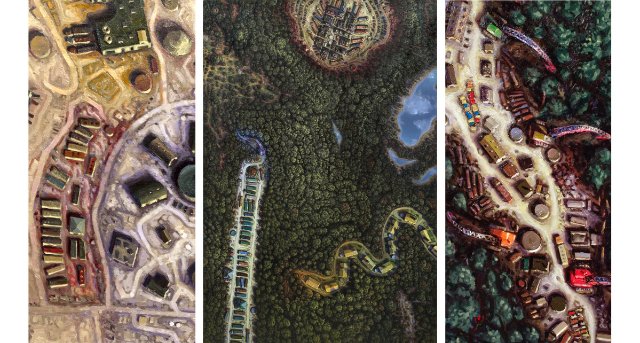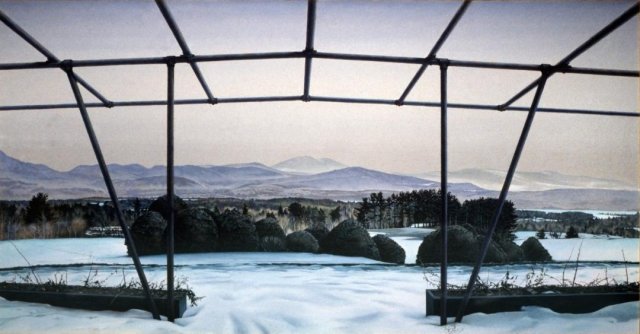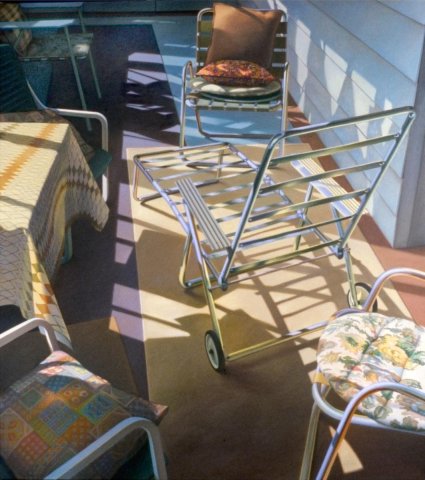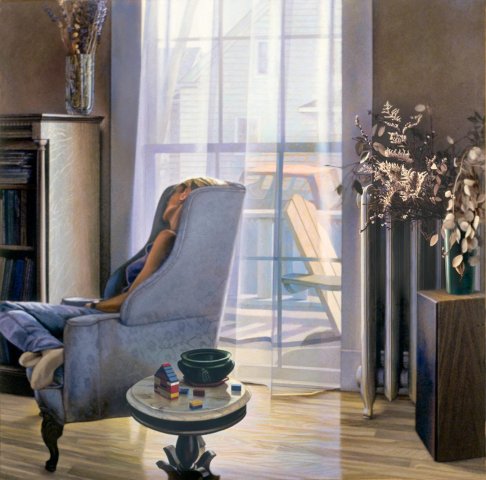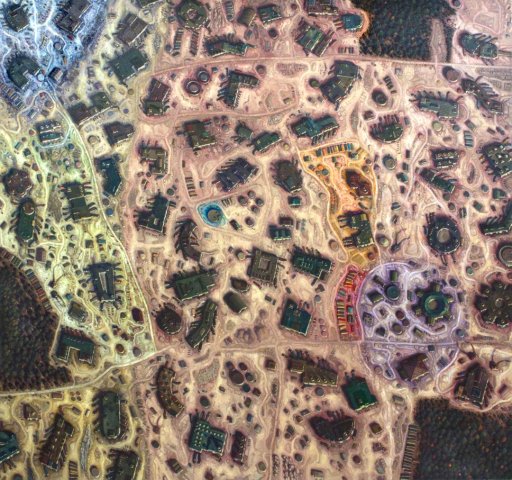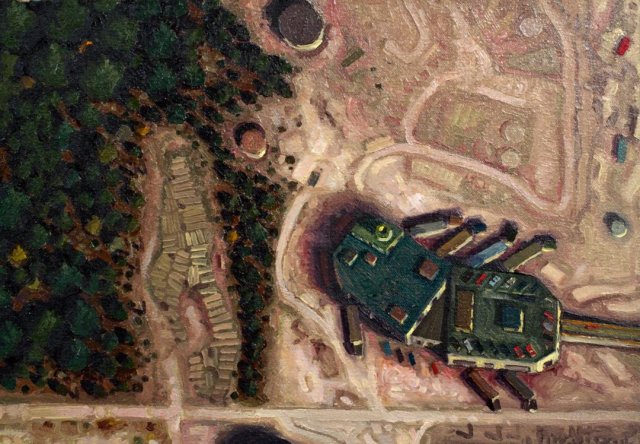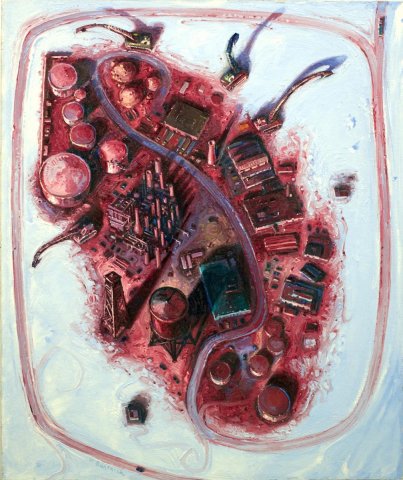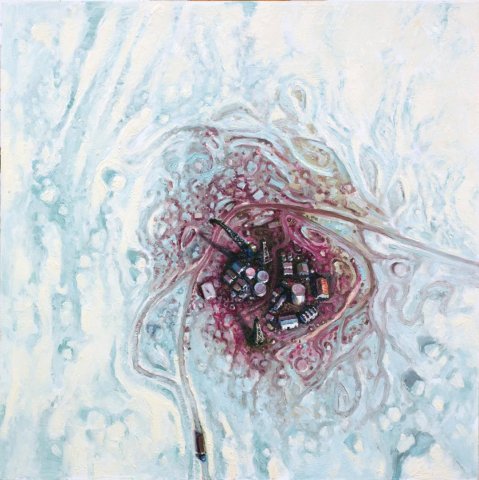Environmental Artist Harry Bartnick
Launches Evocative Website
By: Charles Giuliano - Feb 09, 2024
The artist Harry Bartnick became a friend and colleague when we joined the faculty of New England School of Art & Design in the 1980s. The school later merged with Suffolk University from which he has been Professor Emeritus since 2013.
Over a span of decades I have followed the work with great interest including curating solo and group exhibitions as well as writing reviews.
It is always fascinating to follow the trajectory of aesthetic development of a friend and associate.
The early work, which was shown at Boston’s Helen Shlein Gallery, was subtle in its undermining of Americana with a form of objective realism. The suburban subject matter, seemingly benign, had a compelling and ominous subtext. There was a freeze frame, cinematic essence as though they were establishing shots for a drama or television series like Twin Peaks.
We differ on interpretation of the early paintings. Bartnick responds “It wasn't my intent, and no one that I'm aware of got that type of message. I was generally favorably disposed and respectful towards my subject matter; if anything, what I wanted to project was a strong presence, even monumentality, through careful formal arrangement.”
In fact, a poster by Bartnick was displayed in the set for one such series. At the time that underscored the satirical irony of the understated work.
When asked about it he replied "You remembered that!? The show was '30 Something', the poster was Lake Placid Porch."
A sustaining through line of the meticulously rendered paintings has been a mastery of color. The theme of a garage and yard sale was depicted with a specific time of day, lighting and palette. This evoked layers of perception and observation to what initially seemed quite straight-forward.
That explicates the progressive critical process that drove the subsequent development of the work to more critical and sociological concerns. Conversations with the artist generally entail complex views entailing concerns for environmental destruction emphasized by global warming through rampant development and subsequent deforestation.
The work took the form of aerial views of residential and industrial developments overwhelming nature. He has hired airplanes to make studies for his subjects. There has been significant curatorial and critical response to this work through major solo and group exhibitions, reviews and grants.
In 2001 he was the recipient of a John Simon Guggenheim Fellowship. This allowed him to acquire a large format digital printer. That initiated an expansion from painting to exhibiting photography. Bartnick has been a lifelong traveler entailing summers in Europe with a focus on Italy. Initially, his very selective images were part of personal research. He proved to have an uncanny eye for “The decisive moment.”
Of this grant Bartnick has commented "In 2001 I received a Guggenheim Fellowship to rent a small plane to take photographs above the outskirts of the city, where factories and new housing developments are spreading into the countryside, the fabled Roman Campagna. This was (literally) one of the high points of my career and enabled me to gather hundreds of photographs, which I have, since then, been assimilating, into my paintings."
At a gathering of friends he projected a carousel of slides with an engaging and entertaining commentary. For background he used the evocative sound track from Fellini films. The shots were never of the obvious monuments and tourist attractions.
We were surprised when he projected an atypical shot of the Coliseum. He explained that he wasn’t documenting the iconic structure. Rather, he pointed to the detail of a man perched on the edge at its top. He recalled that the crowd was chanting “Jump, jump.”
In 2004, for NESA&D I curated his exhibition “Italian Journal.” In selection of subject matter and quality of light the photographs were a linear expansion of the paintings expressed in another medium.
The photography offers an alternative to labor intensive canvases with minute topographical patterns. Significantly, in a recent email he commented that “The devil is in the details.”
In the slide show that accompanies this posting with two close-ups he wants us to see the industrial park factory and the highway with new tract housing as invasive species. The intense rendering is a means to an end, not the end itself.
Artist’s Statement (Painting)
Several years ago I presented my paintings (aerial views of the invasive and destructive human presence in forest and arctic landscapes) to a prominent New York art gallery owner. Referring to my environmentalist subject matter, his response was “You don’t have to hit people over the head with it.” But there are existential issues that artists have addressed directly and effectively, with the hope of making a difference. To mention a few: War (Goya, Disasters of War; Picasso, Guernica; Kathe Kollwitz, images of war and class struggle); Slavery (Turner, The Slave Ship; Kara Walker); Terrorism and corruption (Leon Golub, Mercenaries and Interrogation paintings.)
Today, along with these concerns, we can add climate change and its effects, driven by inexorable human population growth and unsustainable consumerism, with no apparent worldwide desire to apply the available solutions, only foot-dragging gestures to forestall the inevitable. Over time, I understood what that art dealer was really saying: “I won’t be able to sell these”, but stated as an aesthetic criticism. Clearly, our agendas differed. The effect of humans on the planet is subject matter too important to be made palatable (i.e. marketable) by obscuring it under expressionist brushwork or fashionably ambiguous imagery so that it can be easily overlooked in favor of a purely "optical" experience.
Nevertheless, that dealer’s comment did give me something to consider. Except for one thing: While, to my mind, I’m being perfectly clear and to-the-point in what I want to convey, the viewers’ responses are sometimes exactly the opposite of what I intended: A painting of the Union Carbide plant in Connecticut, seen from above, with a “head” and “tail” and claw-like appendages for parking, made to appear as if slithering though a dense woodland, appeared to a scientist (who bought the piece) as “man and nature working in harmony”. Another time, a forest penetrated from 3 sides by a snakelike tract house development, a viral-looking industrial park, a parking lot, and a tractor trailer depot, looked like Progress and "capitalism at its best" to a viewer, in spite of the fact that the work was titled "Invasive Species". What I’ve come to realize is that the paintings act as a litmus test of where the viewer’s sympathies lie: An oil drilling camp despoiling a pristine icy terrain might be horrifying to an environmentalist but thrilling to an oil company executive; A tract house development of thousands of new homes, in overall shape reptilian and menacing, may trigger salivation in a real estate agent. So much for “hitting them over the head”.
Influences
It seems to be required, or at least advantageous, for artists to cite the influences of old or modern masters on their work, no matter how negligeable that connection might actually be. At present, when there are no prevailing criteria to determine the quality of a work of art, claiming artistic lineage has become very important. I can make no claim of links to other artists in the form, color and brushwork of my paintings; my influences are mainly in spirit, by artists such as those mentioned above: Artists who took the risk of a head-on imaging of human conflicts and depredations, pulling no punches, loud and clear; art not intended for the living room (or the corporate boardroom). Beside those already mentioned, artists whose work I find compelling in this regard are Edward Burtynsky (large format photographs) and Alexis Rockman (paintings of man’s subversion of the natural world). Other than this, my biggest influence comes from those “big picture”, view-from-above images made by aerial photographers whose focus is the relationship of humanity to the planet, whether their goal is art, design or simply documentation.

